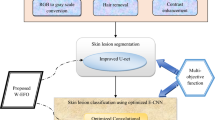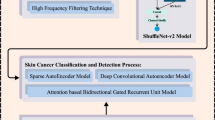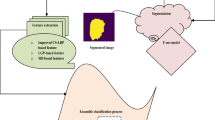Abstract
Background
One of the major health concerns that affect the well-being of people around the world is called as the skin cancer. Among diverse kinds of skin cancer, melanoma is regarded as the most harmful disease along with a higher rate of mortality. Earlier detection as well as the screening process is considered the more complex job for dermatologists due to the enormous variations in morphological attributes of skin cancer. Therefore, there is a requirement for the most reliable and efficient diagnosis system, which has aided dermatologists in adequate decision-making and diagnosis.
Aim
An advanced deep learning technique-based skin lesions classification and detection model for early detection and efficient classification of skin lesions is proposed.
Methods
The dermoscopic images are collected from online sources in the earlier stage. Then, the collected images are segmented with the help of dilated Mask-Regions with Convolutional Neural Networks (RCNN) with an attention mechanism for segmenting the abnormal regions. After that, the segmented images are classified using adaptive hybrid convolution-based ensemble learning (AHC-EL), which is used along with techniques like residual attention network (RAN), MobileNet, and Inception. Here, parameters optimization takes place using a hybrid optimization algorithm namely, fitness-aided battle royale and red deer algorithm (FBR-RDA) for enhancing the classification performance. Finally, the classified outputs of skin lesion classification are obtained based on high ranking between the ensemble learning techniques.
Conclusion
Experimental analysis is carried out between proposed and conventional approaches to verify the efficacy of the recommended method.















Similar content being viewed by others
References
Abdar M, Samami M, Mahmoodabad SD, Doan T, Mazoure B, Hashemifesharaki R, Liu L, Khosravi A, Rajendra Acharya U, Makarenkov V, Nahavandi S. Uncertainty quantification in skin cancer classification using three-way decision-based Bayesian deep learning. Comput Bio Med. 2021;135:104418.
Adegun AA, Viriri S. FCN-based DenseNet framework for automated detection and classification of skin lesions in dermoscopy images. IEEE Access. 2020;8:150377–96.
Adla D, Reddy GVR, Nayak P, Karuna G. Deep learning-based computer aided diagnosis model for skin cancer detection and classification. Distrib Parallel Databases. 2022;40:717–36.
Afza F, Sharif M, Mittal M, Khan MA, Hemanth DJ. A hierarchical three-step superpixels and deep learning framework for skin lesion classification. Methods. 2022;202:88–102.
Alam J, Mohammad MS, Hossain AF, Showmik IA, Raihan MS, Ahmed S, Mahmud TI. S2 C-DeLeNet: a parameter transfer based segmentation-classification integration for detecting skin cancer lesions from dermoscopic images. Comput Biol Med. 2022;150:106148.
Ali S, Miah S, Haque J, Rahman M, Islam K. An enhanced technique of skin cancer classification using deep convolutional neural network with transfer learning models. Mach Learn Appl. 2021;5:100036.
Alshawi SA, AI Musawi GFK. Skin cancer image detection and classification by CNN-based ensemble learning. Int J Adv Comput Sci Appl. 2023;14(5):710–7.
Amir Mohammad Fathollahi-Fard. Mostafa Hajiaghaei-Keshteli, and Reza Tavakkoli-Moghaddam, “Red deer algorithm (RDA): a new nature-inspired meta-heuristic.” Soft Computing. 2020;24:14637–65.
Amit Kumar K. T Y Satheesha, Bizotto Beatriz Lucia Salvador, Sathiyanarayanan Mithileysh and Syed Thouheed Ahmed, “Augmented intelligence enabled deep neural networking (AuDNN) framework for skin cancer classification and prediction using multi-dimensional datasets on industrial IoT standards.” Microprocess Microsyst. March 2023;97:104755.
Ashraf Rehan, Afzal Sitara. Attiq Ur Rehman, Sarah Gul, Junaid Baber, MaheenBakhtyar, Irfan Mehmood, Oh-Young Song and MuazzamMaqsood, “Region-of-interest based transfer learning assisted framework for skin cancer detection.” IEEE Access. 2020;8:147858–71.
AttiqueKhana Muhammad. TallhaAkramb, Yu-Dong Zhangc, and Muhammad Sharif, “Attributes based skin lesion detection and recognition: a mask RCNN and transfer learning-based deep learning framework.” Pattern Recognit Lett. March 2021;143:58–66.
Bao Q, Liu X, Xu J, Xia L, Otikovs M, Xie H, Liu K, Zhang Z, Zhou X, Liu C. Unsupervised deep learning model for correcting Nyquist ghosts of single-shot spatiotemporal encoding. Magn Reson Med. 2023;91(4):1368–83.
Biasi LD, Citarella AA, Risi M, Tortora G. A cloud approach for melanoma detection based on deep learning networks. IEEE J Biomed Health Inform. March 2022;26(3):962–72.
Bozkurt F. Skin lesion classification on dermatoscopic images using effective data augmentation and pre-trained deep learning approach. Multimed Tools Appl. 2022;82:18985.
Brammya G, Praveena S, Ninu Preetha NS, Ramya R, Rajakumar BR, Binu D. Deer hunting optimization algorithm: a new nature-inspired meta-heuristic paradigm. Comput J. 2019.
Cai L, Long T, Dai Y, Huang Y. Mask R-CNN-based detection and segmentation for pulmonary nodule 3D visualization diagnosis. IEEE Access. 2020;8:44400–9.
Choudhary P, Singhai J, Yadav JS. Skin lesion detection based on deep neural networks. Chemometr Intell Lab Syst. 2022;230:104659.
de Souza Farias T, Maziero J. Feature alignment as a generative process. Sec Mach Learn Artif Intell. 2023;5.
Dong X, Yang J, Zhang B, Li Y, Wang G, Chen J, Wei Y, Zhang H, Chen Q, Jin S, Wang L, He H, Gan M, Ji W. Deep learning radiomics model of dynamic contrast-enhanced MRI for evaluating vessels encapsulating tumor clusters and prognosis in hepatocellular carcinoma. J Magn Reson Imaging. 2022;59(1):108–19.
DugganiKeerthana VV. Malaya Kumar Nath and Madhusudhan Mishra, “Hybrid convolutional neural networks with SVM classifier for classification of skin cancer.” Biomed Eng Adv. June2023;5:100069.
Farshi R. Battle Royale Optimization algorithm. Neural Computing and Applications. 2021;33:1139–57.
Hernández A, Amigó JM. Attention mechanisms and their applications to complex systems. Entropy. 2020;23(3):283.
Houssein EH, Gad AG, Wazery YM. Jaya algorithm and applications: a comprehensive review. Metaheuristics Optim Comput Electr Eng. 2021;3–24.
JahinAlam Md. Mir Sayeed Mohammad, Md Adnan Faisal Hossain, Ishtiaque Ahmed Showmik, MunshiSanowarRaihan, Shahed Ahmed and Talha Ibn Mahmud, “S2C-DeLeNet: a parameter transfer based segmentation-classification integration for detecting skin cancer lesions from dermoscopic images.” Comput Biol Med. November 2022;150:106148.
Jiang Y, Yao H, Wu C, Liu W. A multi-scale residual attention network for retinal vessel segmentation. Symmetry. 2019;13(1):24.
Jin X, Chi J, Peng S, Tian Y, Ye C, Li X. Deep image aesthetics classification using inception modules and fine-tuning connected layer. 2016 8th International Conference on Wireless Communications & Signal Processing (WCSP). Yangzhou, China; 2016. pp. 1–6.
Lidia Talavera Martínez. Pedro Bibiloni, AnizaGiacaman, Rosa Taberner, Luis Javier Del Pozo Hernando and Manuel González-Hidalgo, “A novel approach for skin lesion symmetry classification with a deep learning model.” Comput Biol Med. June2022;145:105450.
Lu L, Meng X, Mao Z, Karniadakis GE. DeepXDE: a deep learning library for solving differential equations. Society for Industrial and Applied Mathematics. 2021;63(1):208–22.
Malibari AA, Alzahrani JS, Eltahir MM, Malik V, Obayya M, Duhayyim MA, Lira Neto AV, de Albuquerque VHC. Optimal deep neural network-driven computer aided diagnosis model for skin cancer. Comput Electr Eng. 2022;103:108318.
Mohammad Ali Kadampur and Sulaiman Al Riyaee. Skin cancer detection: applying a deep learning based model driven architecture in the cloud for classifying dermal cell images. Inform Med Unlocked. 2020;18:100282.
Ogudo KA, Surendran R, Khalaf OI. Optimal artificial intelligence based automated skin lesion detection and classification model. Comput Syst Sci Eng. 2023;44(1):694–707.
Öztürk Ş, Çukur T. Deep clustering via center-oriented margin free-triplet loss for skin lesion detection in highly imbalanced datasets. IEEE J Biomed Health Inform. September 2022;26(9):4679–90.
Pacheco AGC, Krohling RA. An attention-based mechanism to combine images and metadata in deep learning models applied to skin cancer classification. IEEE Journal of Biomedical and Health Informatics. September 2021;25(9):3554–63.
Qureshi AS, Roos T. Transfer learning with ensembles of deep neural networks for skin cancer detection in imbalanced data sets. Neural Processi Lett. 2023;55:4461–79.
SertanSerte and Hasan Demirel. Gabor wavelet-based deep learning for skin lesion classification. Comput Biol Med. October 2019;113:103423.
Soujanya A, Nandhagopal N. Automated skin lesion diagnosis and classification using learning algorithms. Intell Automat Soft Comput. 2023;35(1):676–87.
Srividhya V, Sujatha K, Ponmagal RS, Durgadevi G, Madheshwaran L. Vision based detection and categorization of skin lesions using deep learning neural networks. Procedia Computer Science. 2020;171:1726–35.
Tang P, Liang Q, Yan X, Xiang S, Zhang D. GP-CNN-DTEL: global-part CNN model with data-transformed ensemble learning for skin lesion classification. IEEE J Biomed Health Inform. October 2020;24(10):2870–82.
Tembhurne JV, Hebbar N, Patil HY, Diwan T. Skin cancer detection using ensemble of machine learning and deep learning techniques. Multimed Tools Appl. 2023;82:27501–24.
Wang W, Hu Y, Zou T, Liu H, Wang J, Wang X. A new image classification approach via improved MobileNet models with local receptive field expansion in shallow layers. Computational Intelligence and Neuroscience. 2020.
Wang Y, Louie DC, Cai J, Tchvialeva L, Lui H, Wang ZJ, Lee TK. Deep learning enhances polarization speckle for in vivo skin cancer detection. Optics Laser Technol. 2021;140:107006.
Wei L, Ding K, Hu H. Automatic skin cancer detection in dermoscopy Images based on ensemble lightweight deep learning network. IEEE Access. 2020;8:99633–47.
XiaofeiBian Haiwei Pan. Kejia Zhang, Pengyuan Li, Jinbao Li and Chunling Chen, “Skin lesion image classification method based on extension theory and deep learning.” Multimed Tools and Applications. 2022;81:16389–409.
Xie Y, Zhang J, Xia Y, Shen C. A mutual bootstrapping model for automated skin lesion segmentation and classification. IEEE Transactions on Medical Imaging. July2020;39(7):2482–93.
Zafar M, Amin J, Sharif M, Almas Anjum M, Mallah GA, Kadry S. DeepLabv3+-based segmentation and best features selection using slime mould algorithm for multi-class skin lesion classification. Mathematics. 2023;11(2):364.
Acknowledgements
I would like to express my very great appreciation to the co-authors of this manuscript for their valuable and constructive suggestions during the planning and development of this research work.
Author information
Authors and Affiliations
Contributions
All authors have made substantial contributions to conception and design, revising the manuscript, and the final approval of the version to be published. Also, all authors agreed to be accountable for all aspects of the work in ensuring that questions related to the accuracy or integrity of any part of the work are appropriately investigated and resolved.
Corresponding author
Ethics declarations
Declarations
Ethical approval
Not applicable
Conflict of interest
The authors declare no competing interests.
Additional information
Publisher's Note
Springer Nature remains neutral with regard to jurisdictional claims in published maps and institutional affiliations.
Rights and permissions
Springer Nature or its licensor (e.g. a society or other partner) holds exclusive rights to this article under a publishing agreement with the author(s) or other rightsholder(s); author self-archiving of the accepted manuscript version of this article is solely governed by the terms of such publishing agreement and applicable law.
About this article
Cite this article
Nagadevi, D., Suman, K. & Lakshmi, P.S. An enhanced skin lesion detection and classification model using hybrid convolution-based ensemble learning model. Res. Biomed. Eng. (2024). https://doi.org/10.1007/s42600-024-00350-x
Received:
Accepted:
Published:
DOI: https://doi.org/10.1007/s42600-024-00350-x




